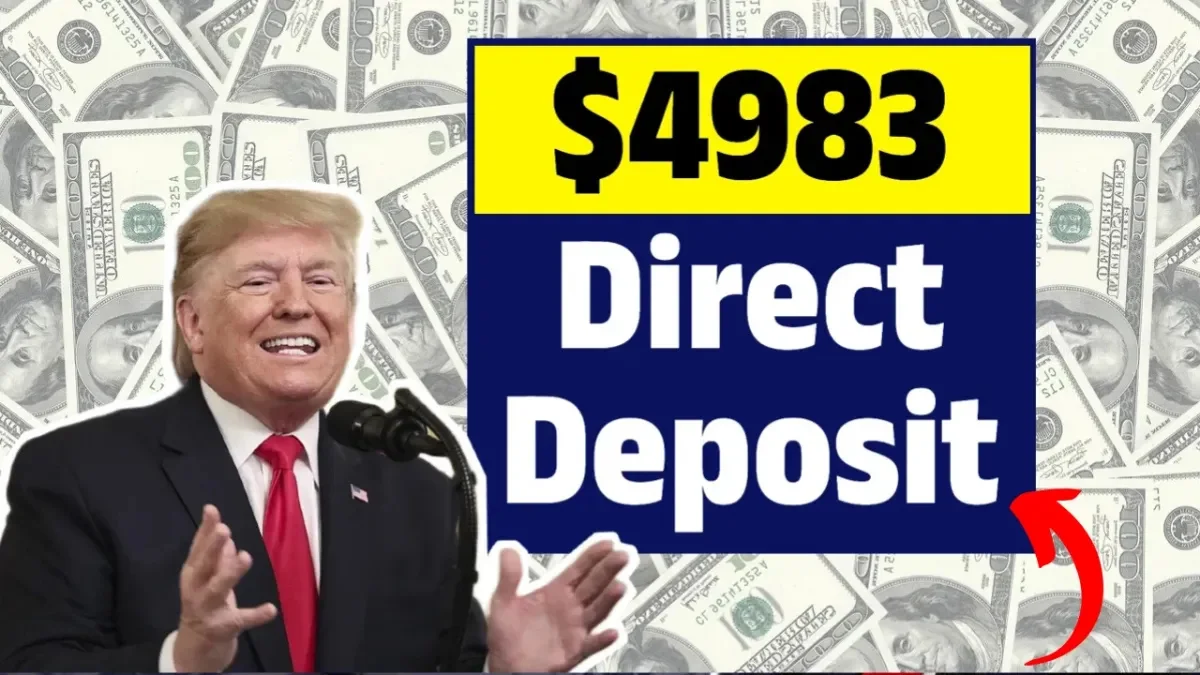US $4,983 Direct Deposit:With rising living costs and inflation putting pressure on household budgets, many Americans are eagerly awaiting good financial news. This November 2025, relief may finally arrive in the form of a $4,983 federal direct deposit, a new payment initiative to help Americans facing financial pressure.
While not officially called a “stimulus check,” this $4,983 payment is expected to function much the same way—providing essential funds directly to eligible citizens through the IRS and the U.S. Treasury Department. For millions, this could bring a sigh of relief at the end of the year.
What is a $4,983 Direct Deposit Payment?
A $4,983 direct deposit is a proposed financial relief measure designed to help Americans overcome current economic challenges. This payment is part of a broader effort to mitigate the impact of inflation, rising housing costs, and higher living expenses through 2025.
The funds will be distributed automatically through the IRS, either via direct deposit, mailed check, or prepaid debit card (EIP card) – depending on how recipients received previous federal payments.
For many families, this deposit could mean paying rent, paying medical bills, or simply regaining a sense of financial stability during the holiday season.
Who is eligible for The $4,983 Payment?
Eligibility for the $4,983 federal direct deposit is determined based on income level, filing status, and profit participation. These payments are intended to help middle- and low-income Americans, retirees, and beneficiaries of federal assistance programs.
Here are details of the expected eligibility guidelines:
| Filing Status | Adjusted Gross Income (AGI) Limit | Payment Amount |
|---|---|---|
| Single Filer | Up to $75,000 | Full $4,983 |
| Married Filing Jointly | Up to $150,000 | $4,983 per filer (total $9,966 per couple) |
| Head of Household | Up to $112,500 | Full $4,983 |
| Above these limits | Reduced payment | Gradual phase-out |
Other eligible groups include:
- Social Security (SSI/SSDI) recipients
- Veterans Affairs (VA) beneficiaries
- Railway Retirement recipients
- Low-income non-filers who qualify based on their benefit records
Those whose income exceeds the above income limits may receive a reduced payment based on their income and tax filing information.
When will the $4,983 direct deposit arrive?
Payments are expected to begin in November 2025, and the IRS will administer the payments in multiple phases to ensure timely and accurate delivery.
Tentative Payment Schedule:
- November 12, 2025: Direct deposits for taxpayers with active banking information on file.
- November 18-24, 2025: Deposits for Social Security, Small Business (SSI), Small Business Development (SDI), and VA beneficiaries.
- November 25-December 5, 2025: Paper checks and prepaid debit cards will be sent to remaining eligible recipients.
Those who opted for direct deposit will receive their funds the fastest. Paper checks may take a few additional business days to arrive depending on mail delays.
How to Receive Your Payment
You don’t need to apply for a direct deposit of $4,983. The IRS will automatically send the payment based on the latest tax or benefit records it has.
You’ll receive it as follows:
- Direct Deposit: Automatically deposited into your registered bank account – the fastest and most secure option.
- Paper Check: If no direct deposit information is available, it will be mailed to the address on record.
- Prepaid EIP Card: Sent to individuals without a bank account.
To avoid delays, make sure your bank account and mailing address are correct on IRS.gov or through your Social Security or VA account.
IRS Instructions for Citizens
The IRS has emphasized some key steps to ensure a smooth process for Americans:
- If you haven’t yet filed your 2024 tax return, file it – this determines eligibility.
- Update your banking details using the IRS “Get My Payment” tool (if activated).
- Beware of fraud: The IRS will never ask for your personal or banking information via call, text, or email.
Monitor the official IRS and Treasury websites for payment dates and eligibility updates.
Why This Payment is Important
Even in 2025, many Americans will continue to grapple with the long-term effects of inflation. For some, this $4,983 payment could prove to be the difference between falling behind and staying ahead.
Seniors can use it to manage healthcare costs, parents can afford childcare, and working Americans can pay off debts or prepare for year-end expenses. This program is more than just a check, it’s a symbol of reassurance—that the federal government understands the challenges facing ordinary citizens.
Frequently Asked Questions (FAQs)
1. Is the $4,983 payment officially confirmed?
As of October 2025, discussions are in advanced stages, and the payment program is expected to be finalized before the end of November.
2. Who qualifies for the payment?
Most U.S. citizens with incomes under $75,000 (single) or $150,000 (joint), as well as Social Security, VA, and SSI beneficiaries.
3. Do I need to apply for this payment?
No. The IRS will issue payments automatically using tax or benefit data.
4. How will I receive the payment?
Via direct deposit, paper check, or prepaid EIP card — depending on your current IRS record.
5. Will this affect my existing benefits?
No. The payment is non-taxable and won’t reduce your Social Security, SSI, or VA benefits.
6. When can I expect the payment?
Most Americans can expect deposits beginning mid-November 2025, with all payments expected to be distributed by early December.

